Jeannine Atkins's Blog, page 38
January 31, 2011
Orra White Hitchcock: An Amherst Woman of Art and Science
Yesterday Peter and I went to the show Orra White Hitchcock (1796–1863): An Amherst Woman of Art and Science at Mead Art Museum. This museum at Amherst College is free, with donation suggested, and on Sundays, it’s open until midnight. And classes in Buddhist meditation in front of paintings and tai chi are offered to students. What’s not to love?
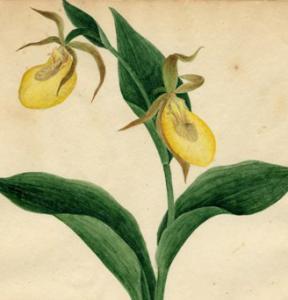
We heard the show’s co-curators, Robert L. Herbert, professor emeritus of humanities at Mount Holyoke College, and Daria D’Arienzo, former head of Amherst’s Archives and Special Collections, talk about finding this work and arranging it for display in what seemed a labor of love. We learned that Orra White Hitchcock was the wife of Edward Hitchcock, minister, scientist, professor and president of Amherst College for ten years, and mother to their eight children. She made watercolors, drawings, and prints of native plants and local scenery as well as hand-colored drawings of fossils and geological designs on muslin that her husband hung on the walls as visual aids for his lectures.
Three rooms were filled with artwork that showed a small amount of what this prolific artist did, and the curators hope this show will bring even more to light. Orra White Hitchcock encouraged her children to see the world as artists and scientists, too, and some of their work, along with their mother’s, was probably passed along through the family as well as to neighbors. The show included cases with paintings of flowers and grasses, beautifully rendered, and meant to aid botanical study. Leaves, for instance, might be shown with a view from below as well as above to help identify the plant. Many of the landscapes were meant to illustrate the nature of mountains and rivers over time. And, of course, the works on cloth were pedagogical, but it was amazing to see mastodons and cross-sections of the earth’s crust, which may have been executed on a kitchen or dining room table, perhaps in between making pies. Who knows? We have the art, some diaries, a lot of questions, and sheer wonder for a life filled with art, scientific curiosity, children, students, dogs, and chickens, too.

We heard the show’s co-curators, Robert L. Herbert, professor emeritus of humanities at Mount Holyoke College, and Daria D’Arienzo, former head of Amherst’s Archives and Special Collections, talk about finding this work and arranging it for display in what seemed a labor of love. We learned that Orra White Hitchcock was the wife of Edward Hitchcock, minister, scientist, professor and president of Amherst College for ten years, and mother to their eight children. She made watercolors, drawings, and prints of native plants and local scenery as well as hand-colored drawings of fossils and geological designs on muslin that her husband hung on the walls as visual aids for his lectures.
Three rooms were filled with artwork that showed a small amount of what this prolific artist did, and the curators hope this show will bring even more to light. Orra White Hitchcock encouraged her children to see the world as artists and scientists, too, and some of their work, along with their mother’s, was probably passed along through the family as well as to neighbors. The show included cases with paintings of flowers and grasses, beautifully rendered, and meant to aid botanical study. Leaves, for instance, might be shown with a view from below as well as above to help identify the plant. Many of the landscapes were meant to illustrate the nature of mountains and rivers over time. And, of course, the works on cloth were pedagogical, but it was amazing to see mastodons and cross-sections of the earth’s crust, which may have been executed on a kitchen or dining room table, perhaps in between making pies. Who knows? We have the art, some diaries, a lot of questions, and sheer wonder for a life filled with art, scientific curiosity, children, students, dogs, and chickens, too.
Published on January 31, 2011 18:08
January 29, 2011
Bruce Laird's Art
One of our family’s day-after-Christmas traditions is for my husband to gather with his brother around a computer and talk about the things it can do. This year that talk resulted in Bruce starting a blog, or maybe reviving one that didn’t last more than long past last Christmas. It’s exciting for us to see some of Bruce’s paintings up on blARTblog.
I hope you’ll check out the blog. Below are some examples with Bruce, here with his very supportive wife, Catherine.
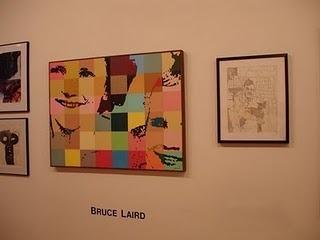
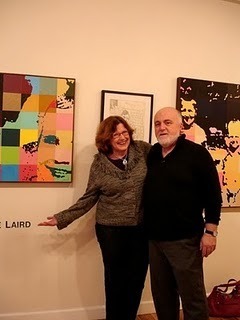
And this work is from another group show at 10 Grace Gallery in Great Neck, Long Island.
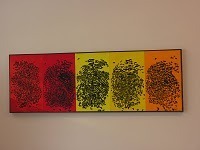
It is a lot of fun to be part of such an artistic family! And now, another blogger! (Ben, we're waiting for you.)
Published on January 29, 2011 17:46
January 28, 2011
Stepping Toward the Brink-- of Paper
Last Friday I posted a poem with a bird in it that I took out then put back in, raising some fuss among my fellow or sister bird-lovers and writers. The poem was about the need to watch every word, um, like a hawk. This week I was inspired to write about the kinder moments of writing. It’s wise to question everything, but first we have to find our way in, and if that’s through birds, who do so much for keeping a homebody sane in January, that’s great. Especially when the chickadees or woodpeckers are both close to what I might see outside the window with just enough magic or metaphor to take me somewhere new. The trick is to show them from in new lights: maybe from beneath the wings, or focus on their clever feet or maze of tracks in snow. I try to get a bird accurate, then tilt a wing to an impossible angle, choose a color nature never saw, improvise enough so the bird can break through paper.
In the poem below I’m not trying to suggest my work is anywhere near to the greatness of Charlotte’s Web or The Lion, the Witch, and the Wardrobe. Just that I’m following a method that any of us might of stepping from reality to the fantastic, or what we know to what we don’t, toward our own Maine farms or Narnias.
Under the Whispers
E.B. White fed real pigs and mucked his old barn,
studied the anatomy of spiders and their birthing habits
before he made Wilbur and Charlotte speak so we’d believe every word.
C. S. Lewis played as a boy in his grandparent’s wooden wardrobe.
He gave us the feel of old fur coats, the scent of mothballs,
before Lucy stepped through pine boughs onto snow.
I follow a real girl hurrying over cobblestones by brick townhouses,
until by the frog pond in the Public Garden her small hand casts
a shadow, pointing towards something always there, but never seen.
Jeannine Atkins, all rights reserved
Please visit Elaine, who’s hosting the Poetry Friday Roundup at Wild Rose Reader.
Published on January 28, 2011 06:43
January 26, 2011
January Time Traveling
This month there’s a lot of snow, and worse, ice, here in Massachusetts. I think gardening books may sell more now than at any other time of year, though I haven’t researched that. We mark our calendars for the bulb shows promised at local colleges coming not quite soon enough, where the air is fragrant with green leaves and blossoms that make breathing much more fun.
And sometimes we hit a winter in our writing. I have a solid draft of my work in progress, some of which is set in nineteenth century Rome, some in Boston. I began the novel-in-verse with research about those places as well as the central character’s life. I’ve been working on the narrative arc and honing lines for a while and feel not exactly stuck, but hemmed in, the way the icy driveway makes me think twice about heading anywhere. Tucking the manuscript away for a while is one smart way to know I’ll come back to it fresh, but I’m not quite at that point. So yesterday I made a trip to the library and went through the travel sections.
I generally keep to a regimen set when my daughter was going to school of writing during school hours, then doing research, which doesn’t take as much concentration for me, after 3 p.m. So today in late afternoon here are some of the books I’ll daydream over.

These are places where my character walked, though I’ll have to check dates. (yay for Italy which keeps a lot the same, and I’m sorry about Boston, a city I love, which with good reason has changed a lot in 150 years). Photographs from old books help me imagine things my character saw. I do have a question: did confessionals in St. Peter’s look as they do now? But mostly I’m hoping for the luck of finding an image that may pull together holes, or start a new thread, or just plain sparkle, and carry me happily back to work.
Published on January 26, 2011 06:12
January 24, 2011
Conversations and Raspberry Muffins
Toby Speed is starting a new feature at The Writer’s Armchair called Three for Tea. Today she invited me and authors Clara Gillow Clark and Blythe Woolston to talk about ways we know when we have a project worth pursuing and how we plunge in. I hope you’ll go to Toby’s blog for green tea, oatmeal cookies, to listen in and, if you like, add your own take on how you know you’ve hit on an idea you can take through the long haul – or that will take you through.

I wish I could put out a plate of the muffins I made yesterday, but here’s the recipe:
Raspberry Muffins (makes 9 of hefty size)
Ingredients:
Two and a half cups flour
One Tablespoon baking powder
One third to a half cup sugar
One egg
One cup buttermilk (or add one Tablespoon white vinegar to one cup milk and let sit a minute)
Four tablespoons vegetable oil
One cup raspberries – may be frozen
Preheat the oven to 400. Line muffin tins with paper liners. Mix dry ingredients. Beat the eggs with milk and oil. Add this to dry ingredients and blend quickly and lightly; do not beat. Fold in the berries. Spoon into pans and bake about 20 minutes until golden-brown.-ish.
Published on January 24, 2011 10:03
January 21, 2011
A Conversation with the Poet
I have to watch from overdoing some tendencies when I write poetry. Here’s a recent talking-to I had with myself.
A Conversation with the Poet
Be leery of words too common in the trade.
Enrapture, begone, even blue should be used with caution.
Avoid sunrise, sunsets, and apple blossoms.
Better to find new words for where day breaks, night collapses.
Choose the apple tree when fruit and leaves have bared
crooked gray branches to cold air.
I’m sorry to tell you the birds will have to go.
We hear their song, yes, but they’ve been making noise too long.
Skimp on what glitters. Be prudent describing the acrobatics of cats.
If you insist on roses, consider thorns instead of petals,
though in every case, watch out for too much metaphor
as you track down the secrets of the universe,
mysterious codes that crack paths to happiness
or a single bird on a branch. You can change your mind.
Birds are all right to put in poems after all.
For the Poetry Friday roundup, please visit A Teaching Life, a blog I recently discovered and like very much for Tara’s takes on poetry and a variety of ways to write.
Published on January 21, 2011 06:29
January 18, 2011
Treasure Hunts
The snow is falling gorgeously, the birds are busy at the feeder. It’s a perfect day for writing, but maybe it’s the way weather limits choice that make me itchy. Sometimes sitting down and dedicating the day to words feels hard. When that happens, I often think of writers behind me and beside me. I know the task wasn’t easy for writers whose work I love, and I feel strengthened by writers who report on their blogs ambitions to rough out a chapter a day through the month or turn off the internet and stride toward a deadline. Other times it’s sheer willfulness that gets me back to work. I tell myself I’m going to finish whether or not anyone else in the world cares.
But fluffy white flakes fall outside and I’m cozy in here, and not in the mood for lectures. So, always grateful for company, what’s getting me to stay in my chair is the thought of writing as a treasure hunt.
I remember long games of peek-a-boo with babies who seemed astonished every time they dropped their small hands to see your face. Those babies got a little older, and could be entertained with treasure hunts. It didn’t matter what the treasures were. The looking in dim corners and under beds and boxes was the fun. With just a bit of mixing things up, old toys or folded paper clues could look astonishing.
That’s what I’m hoping to have here today at my computer. I’ve got a lot of images and lines to work with. I’ll scramble and unscramble, hide and seek. And if the day goes well, I hope to surprise myself and grin like a kid at something old yet new. I didn’t realize how shiny it always was.

Published on January 18, 2011 07:32
January 14, 2011
Poetry Friday: The Color of Lost Rooms by Irene Latham
Many of us know Irene Latham as the author of Leaving Gee’s Bend, a novel for middle readers about a ten-year-old’s quest in 1932 rural Alabama, which pays tribute to not just the strength of one girl but a whole a community of quilt makers. Others know Irene through her participation in Poetry Friday, where I’ve found her taste in poems is often similar to mine. Which made me excited to get my hands on her second collection of poetry. The Color of Lost Rooms didn’t disappoint. My heart beat harder at each of the first few poems I read, and then put down the book, so I could start all over again.
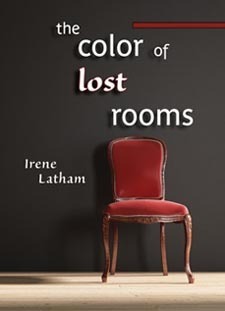
Many of these poems were inspired by paintings, and many of those were seen at the National Museum of Women in the Arts. So we get to discover a lot of women from the past, seen through the prism of a poet. Maria Sibylla Merian’s insects seem to flutter off the engravings. Frida Kahlo’s dress tells a story. I especially loved “Breakfast of the Birds,” "after a painting by Gabriele Munter." Many lost rooms here are colored by those mostly forgotten who stood close to what we think of as history. We have poems told from the views of Einstein’s daughter, Audubon’s Mother, and one of Picasso’s wives.
Other free verse poems, usually in couplets, tercets, or four line stanzas, have more domestic settings, and tell of a daughter’s changing relationship to her mother, an elderly gardener’s devotion to his wife, and a marriage. “Love Poem with Christmas Lights” begins, “That first Christmas/without your mother, I watched you unpack…” There are no more allusions to the loss. Instead, observation of the plastic ornaments, busted bulbs, a wrench and racket quietly broke my heart.
Most of these poems are about people who are utterly distinct, and tell short stories in vivid language. Lucky you who have yet to read these. Ordering information is on Irene’s website, where you can also learn more about her fiction. Or quilts!
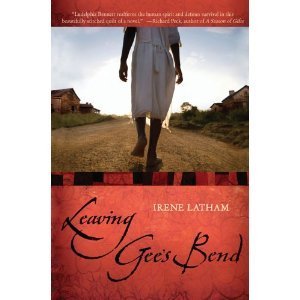
For the Poetry Friday roundup, please visit Laura Purdie Salas at Writing the World for Kids.
Published on January 14, 2011 06:38
January 12, 2011
When the Story Isn't So Sweet
Maybe it begins with people asking How are you? in a way that makes it clear there’s one option for an answer. Or those casual conversations where people confess a problem and there’s a beat after the compassionate murmur, a silence that seems to call for the feel-good twist or lesson, the silver lining. I’ve done that, smiling way too soon. Sometimes it’s appropriate, but often it feels like a slap to the speaker. And may be the place where a writer is born, as we look for time and silence and paper to write our hard and complicated truths.
Even if we’re writing something about mothers and children more perfect than real, or more of a romance than a real relationship, writing can be tough. But when the story doesn’t swing toward a happy ending, there’s one more reason for doubt to sprawl across our shoulders. Sometimes I can’t quite shrug her off, but on better days I manage to call up a girl whose face I can’t remember but who sat by the professor in a college writing workshop. She was well dressed and never stumbled over words. I didn’t really know her, but somehow I imagined her coming from a together family and being in a supportive relationship that would slip right towards marriage and well-adjusted children. At any rate, she didn’t seem anything like me. But once I submitted for critique a story based on my messy life, and I remember her pronouncing it good and honest and saying, “The character seems just like me.” And the professor, who was decades older than us and male, nodded, too.
Was it possible other people carried around secrets, flaws, unhealthy obsessions, and memories of disasters? Of course it was. I’d never recognize this girl today, even if she hadn’t aged. But when doubt crawls to my corner, it’s the single faces I try to call into the room. This young woman at college, or the sole girl in a hall filled with writers with more and higher stacks of books on their tables. This girl chose Aani and the Tree Huggers as her one book to buy because Aani looked a little like her sister. As we locked eyes, the lines toward other more popular authors blurred into the background. That’s the state I imagine myself back to.
These one-to-one moments aren’t going to pay the bills or lead to another book getting published. But they’re where my strength comes from: one person heard and it seemed to matter. So I try again to write the way some people speak in front of an audience, catching one pair of eyes. It’s me to you or you to me and always word by word.
Even if we’re writing something about mothers and children more perfect than real, or more of a romance than a real relationship, writing can be tough. But when the story doesn’t swing toward a happy ending, there’s one more reason for doubt to sprawl across our shoulders. Sometimes I can’t quite shrug her off, but on better days I manage to call up a girl whose face I can’t remember but who sat by the professor in a college writing workshop. She was well dressed and never stumbled over words. I didn’t really know her, but somehow I imagined her coming from a together family and being in a supportive relationship that would slip right towards marriage and well-adjusted children. At any rate, she didn’t seem anything like me. But once I submitted for critique a story based on my messy life, and I remember her pronouncing it good and honest and saying, “The character seems just like me.” And the professor, who was decades older than us and male, nodded, too.
Was it possible other people carried around secrets, flaws, unhealthy obsessions, and memories of disasters? Of course it was. I’d never recognize this girl today, even if she hadn’t aged. But when doubt crawls to my corner, it’s the single faces I try to call into the room. This young woman at college, or the sole girl in a hall filled with writers with more and higher stacks of books on their tables. This girl chose Aani and the Tree Huggers as her one book to buy because Aani looked a little like her sister. As we locked eyes, the lines toward other more popular authors blurred into the background. That’s the state I imagine myself back to.
These one-to-one moments aren’t going to pay the bills or lead to another book getting published. But they’re where my strength comes from: one person heard and it seemed to matter. So I try again to write the way some people speak in front of an audience, catching one pair of eyes. It’s me to you or you to me and always word by word.
Published on January 12, 2011 07:01
January 7, 2011
The Art of Losing: Poems of Grief and Healing, edited by Kevin Young
A friend recently asked if I could suggest a poem she might read at a memorial service for her grandmother. I love those kinds of requests, that set off mini research projects. And this one was made relatively easy because I’d recently bought The Art of Losing: Poems of Grief and Healing, edited by Kevin Young (Bloomsbury, 2010). The selections are from a poet and anthologist working today and has a fresh feel. For me, the anecdotal nature of many poems makes it perhaps a better book to read through when dealing with grief than a perfect gift for ministers of any kind. But Kevin Young suggests it can be used for both individuals and ceremonies, and the subject index notes poems perhaps best suited for funerals. It also categorizes the poems according to who’s being mourned including: mothers, fathers, siblings, friends and strangers, and daughters and sons: this last includes grief for children not born, or those who survived for less than a day, which I found some of the most heart-breaking poems.
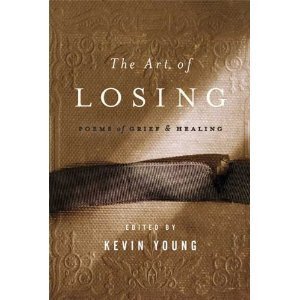
Kevin Young was inspired to put together this collection after writing about the death of his father in his latest poetry collection, Dear Darkness, and he organized this anthology according to some of what he experienced: reckoning, regret, remembrance, ritual, recovery, and redemption. He writes, “A poem must be willing to be unwilled, beckoned by need.” And the need for comfort in the face of death may be answered, for a time, by one of the wonderful elegies by Donald Hall, Galway Kinnell, Natasaha Tretheway, Mark Doty, Lucille Clifton and many others.
I typed my friend copies of poems by Emily Dickinson, Robert Frost, and Mary Oliver, and the one I thought she’d choose by Jane Kenyon: Let Evening Come. I love that poem. I think the Dickinson and Frost are beautiful, but perhaps require more pondering – asking to be looked at on a page, rather than be heard among many other words. And Jane Kenyon’s repetition, a sort of chant, beautifully leads us from grief back to the world.
Even when grief isn’t a big part of your present life, or perhaps even better, this is a good collection for poetry lovers. And you can be the person someone might come to asking for a poem; or feel free to give me a nudge. You know this is the work we live for: answering the question, Any idea of what I should read? It must matter, even when you’re left unsure whether your choices hit the mark. My friend didn’t read aloud the poems I selected or any other, but stayed in the pew to let her daughter read When Great Trees Fall by Maya Angelou. That must have been something, too.
For a roundup of Poetry Friday posts, please visit: Irene Latham at Live. Love. Explore. I’m currently enchanted with Irene’s latest volume of poems, The Color of Lost Rooms, which I’ll blog about later this month.
Published on January 07, 2011 06:17



